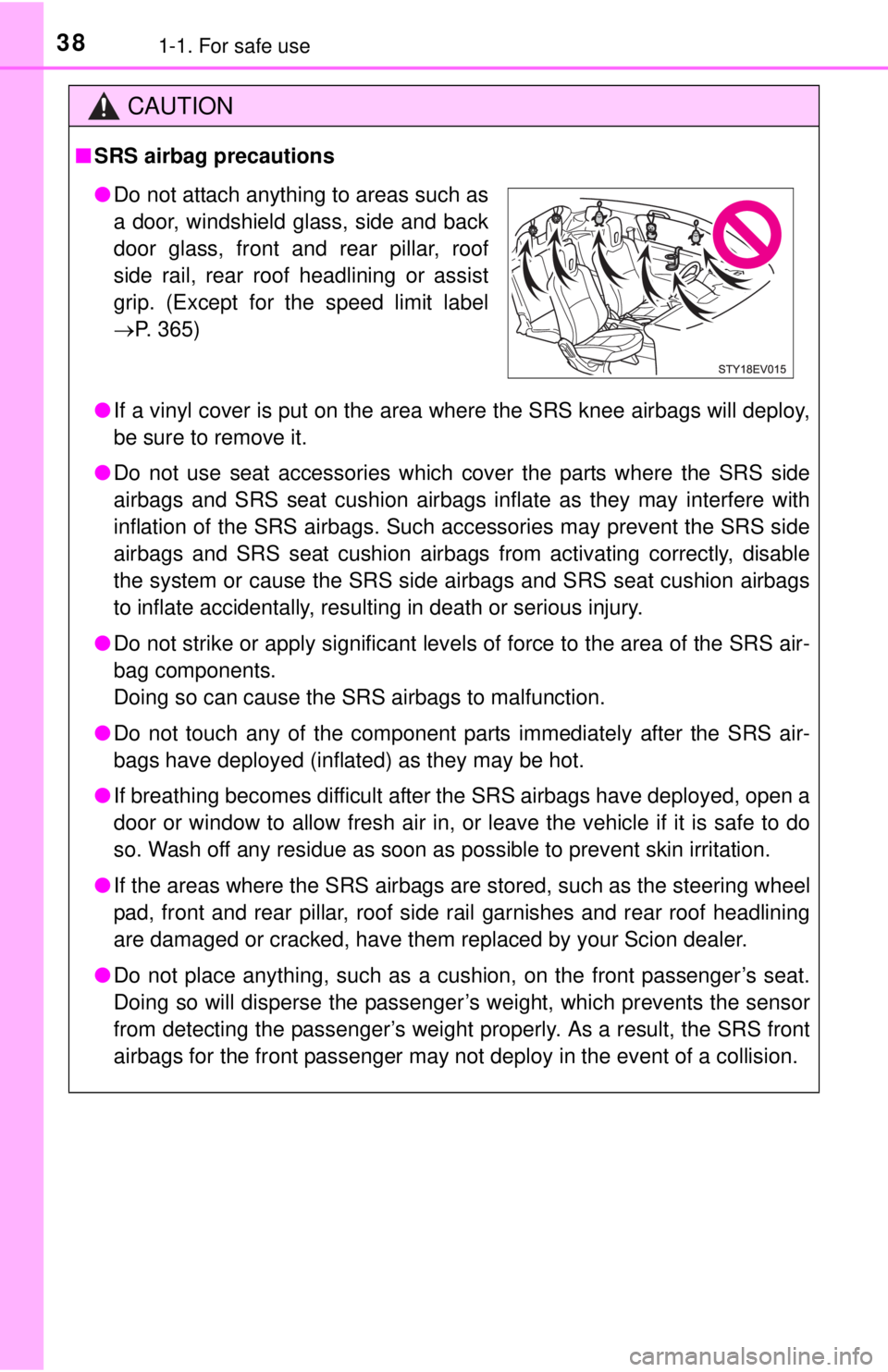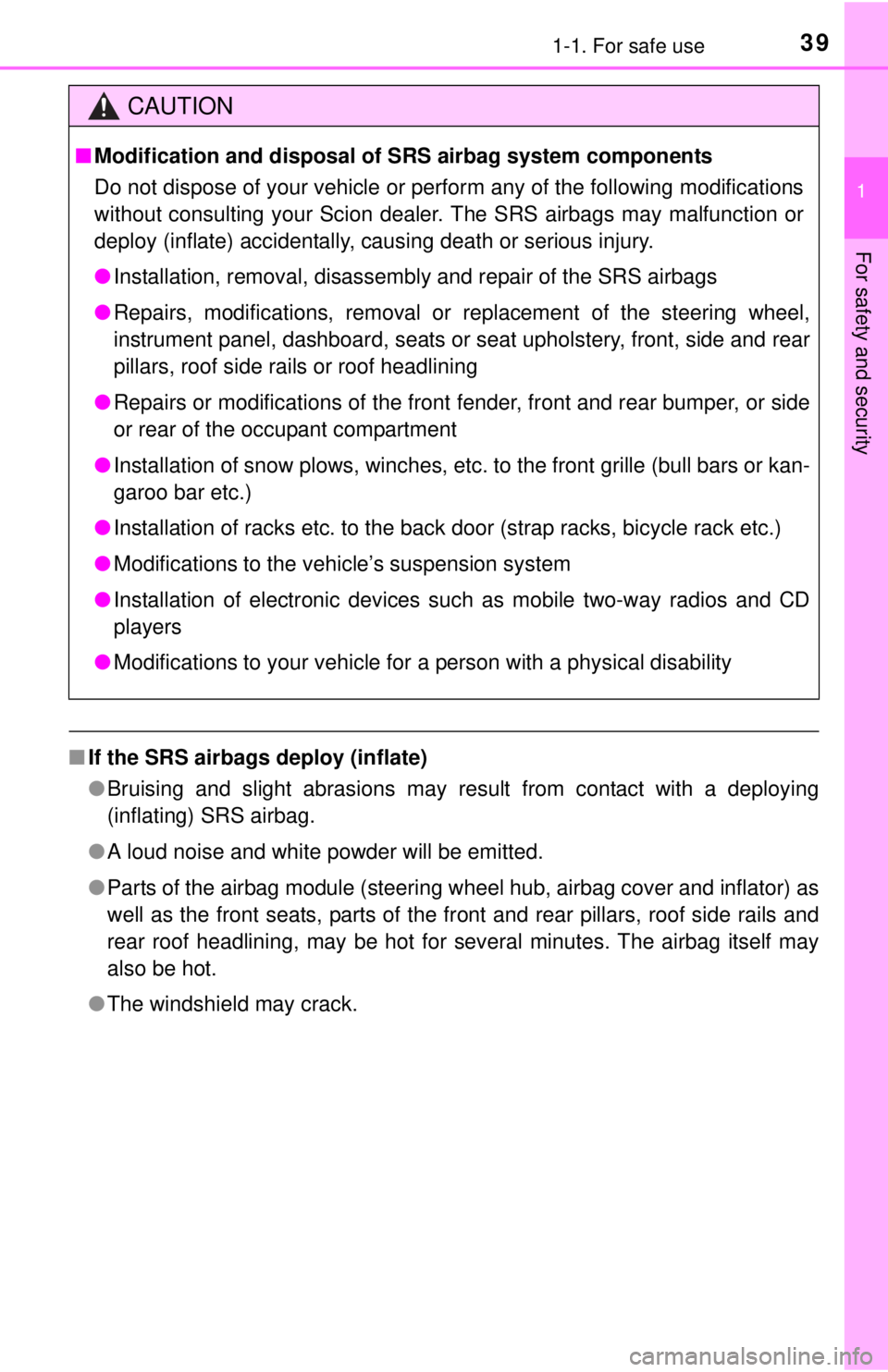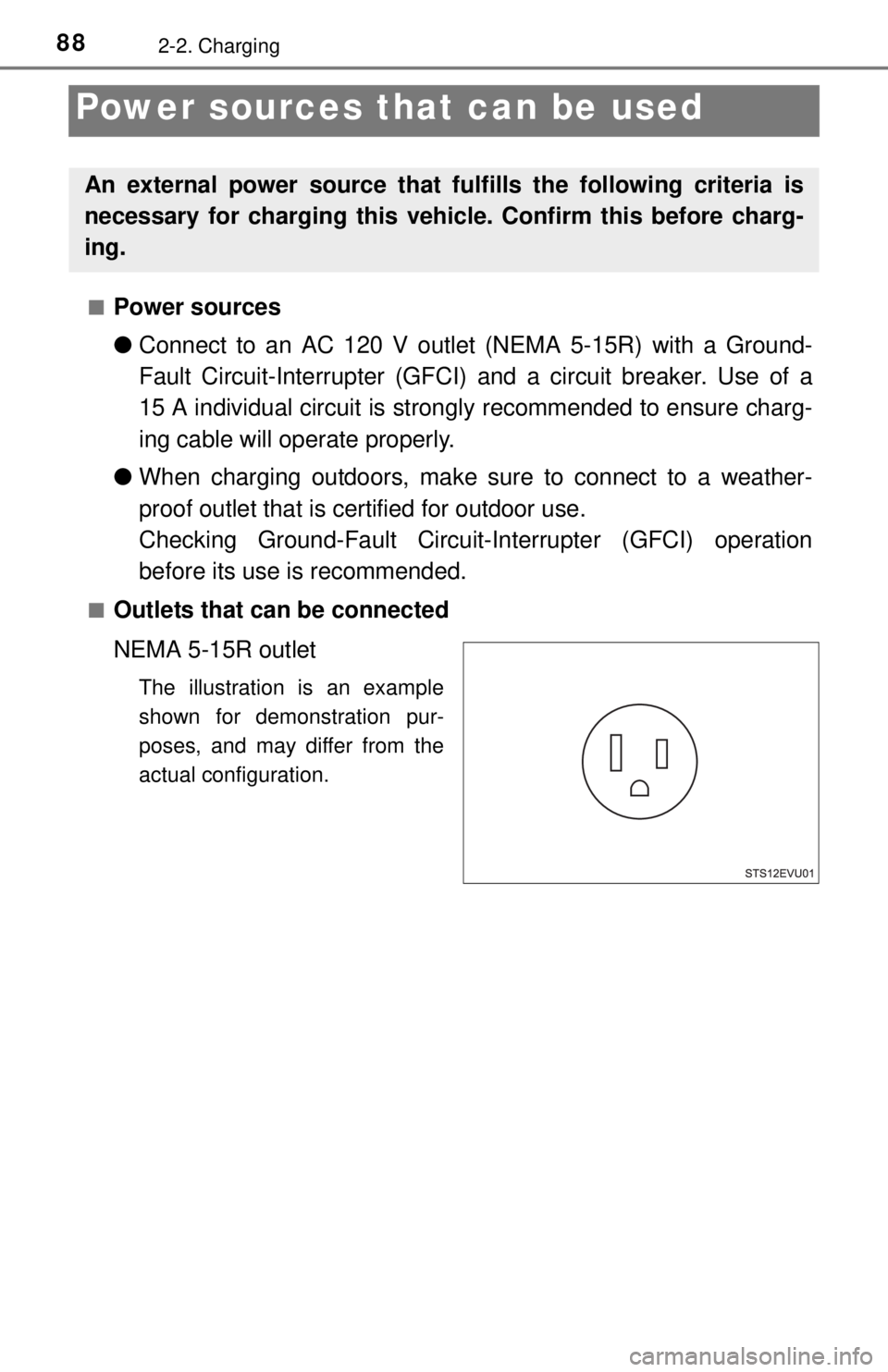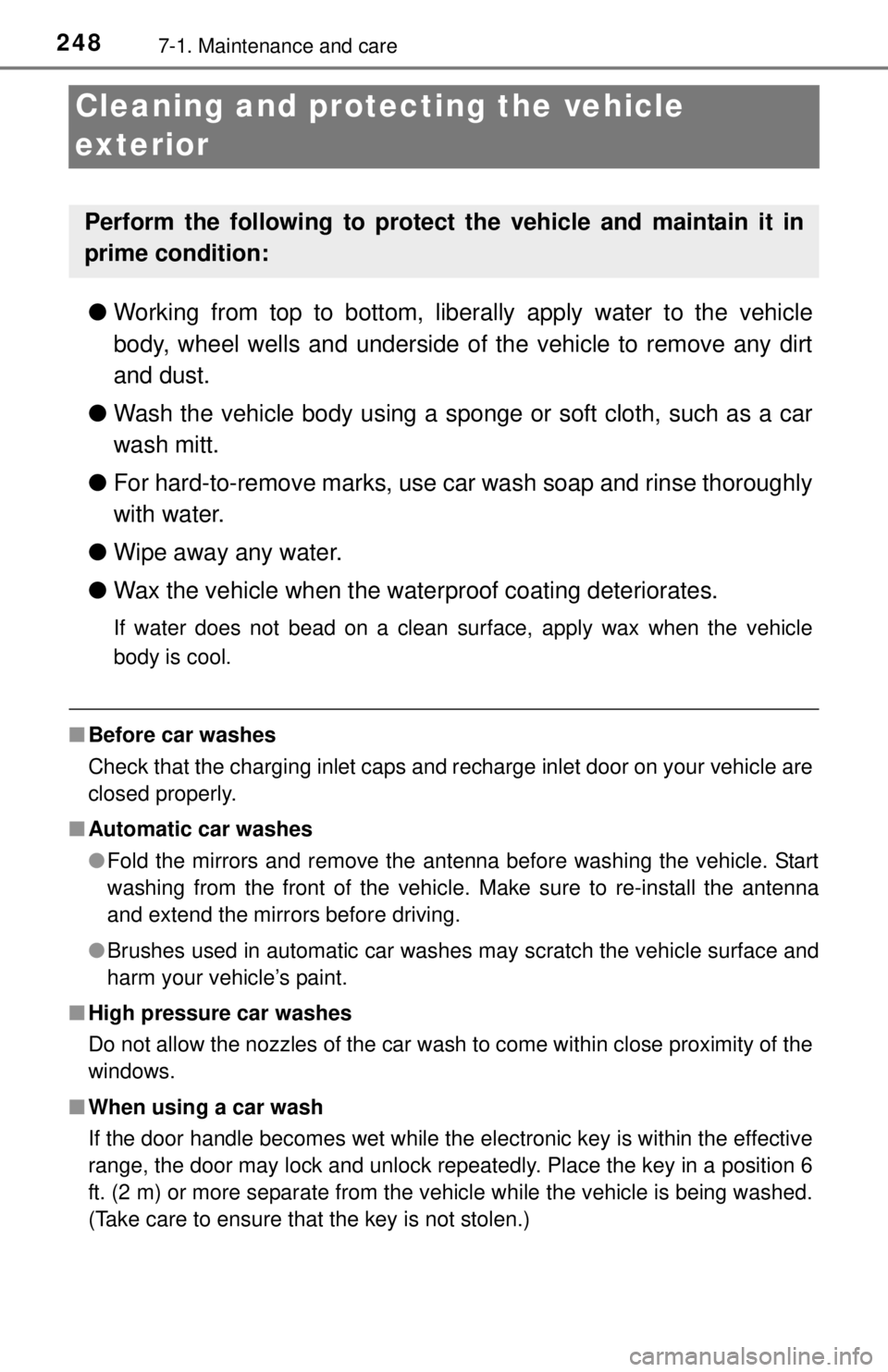roof TOYOTA iQ EV 2013 Owners Manual (in English)
[x] Cancel search | Manufacturer: TOYOTA, Model Year: 2013, Model line: iQ EV, Model: TOYOTA iQ EV 2013Pages: 444, PDF Size: 7.34 MB
Page 37 of 444

371-1. For safe use
1
For safety and security
CAUTION
■SRS airbag precautions
● Do not allow a child to stand in front of
the SRS front passenger airbag unit or
sit on the knees of a front passenger.
● Do not allow the front seat occupants to
hold items on their knees.
● Do not lean against the door, the roof
side rail or the front, side and rear pil-
lars.
● Do not allow anyone to kneel on the
passenger seat toward the door or put
their head or hands outside the vehicle.
● Do not allow anyone to kneel on the
rear seat toward the back door.
● Do not attach anything to or lean any-
thing against areas such as the dash-
board, steering wheel pad and lower
portion of the instrument panel.
These items can become projectiles
when the SRS driver, front passenger
and knee airbags deploy.
Page 38 of 444

381-1. For safe use
CAUTION
■SRS airbag precautions
● If a vinyl cover is put on the area where the SRS knee airbags will deploy,
be sure to remove it.
● Do not use seat accessories which cover the parts where the SRS side
airbags and SRS seat cushion airbags inflate as they may interfere with
inflation of the SRS airbags. Such accessories may prevent the SRS side
airbags and SRS seat cushion airbags from activating correctly, disable
the system or cause the SRS side airbags and SRS seat cushion airbags
to inflate accidentally, resulting in death or serious injury.
● Do not strike or apply significant levels of force to the area of the SRS air-
bag components.
Doing so can cause the SRS airbags to malfunction.
● Do not touch any of the component parts immediately after the SRS air-
bags have deployed (inflated) as they may be hot.
● If breathing becomes difficult after the SRS airbags have deployed, open a
door or window to allow fresh air in, or leave the vehicle if it is safe to do
so. Wash off any residue as soon as possible to prevent skin irritation.
● If the areas where the SRS airbags are stored, such as the steering wheel
pad, front and rear pillar, roof side rail garnishes and rear roof headlining
are damaged or cracked, have them replaced by your Scion dealer.
● Do not place anything, such as a cushion, on the front passenger’s seat.
Doing so will disperse the passenger’s weight, which prevents the sensor
from detecting the passenger’s weight properly. As a result, the SRS front
airbags for the front passenger may not deploy in the event of a collision.
●Do not attach anything to areas such as
a door, windshield glass, side and back
door glass, front and rear pillar, roof
side rail, rear roof headlining or assist
grip. (Except for the speed limit label
P. 365)
Page 39 of 444

391-1. For safe use
1
For safety and security
■If the SRS airbags deploy (inflate)
●Bruising and slight abrasions may result from contact with a deploying
(inflating) SRS airbag.
● A loud noise and white powder will be emitted.
● Parts of the airbag module (steering wheel hub, airbag cover and inflator) as
well as the front seats, parts of the front and rear pillars, roof side rails and
rear roof headlining, may be hot for several minutes. The airbag itself may
also be hot.
● The windshield may crack.
CAUTION
■Modification and disposal of SRS airbag system components
Do not dispose of your vehicle or per form any of the following modifications
without consulting your Scion dealer. The SRS airbags may malfunction or
deploy (inflate) accidentally, causing death or serious injury.
● Installation, removal, disassembly and repair of the SRS airbags
● Repairs, modifications, removal or replacement of the steering wheel,
instrument panel, dashboard, seats or seat upholstery, front, side and rear
pillars, roof side rails or roof headlining
● Repairs or modifications of the front fender, front and rear bumper, or side
or rear of the occupant compartment
● Installation of snow plows, winches, etc. to the front grille (bull bars or kan-
garoo bar etc.)
● Installation of racks etc. to the back door (strap racks, bicycle rack etc.)
● Modifications to the vehicle’s suspension system
● Installation of electronic devices such as mobile two-way radios and CD
players
● Modifications to your vehicle for a person with a physical disability
Page 44 of 444

441-1. For safe use
●The pad section of the steering wheel,
dashboard near the front passenger air-
bag or lower portion of the instrument
panel is scratched, cracked, or other-
wise damaged.
● The seat cushion surface is scratched,
cracked, or otherwise damaged.
● The surface of the seats with the side
airbag is scratched, cracked, or other-
wise damaged.
● The portion of the front pillars, rear pil-
lars or roof side rail garnishes (padding)
containing the curtain shield airbags
inside is scratched, cracked, or other-
wise damaged.
● The portion of the rear roof headlining or
rear pillars containing the rear window
curtain shield airbag inside is scratched,
cracked, or otherwise damaged.
Page 55 of 444

551-1. For safe use
1
For safety and security
CAUTION
■Child restraint precautions
● For effective protection in automobile accidents and sudden stops, a child
must be properly restrained, using a seat belt or child restraint system
depending on the age and size of the child. Holding a child in your arms is
not a substitute for a child restraint system. In an accident, the child can be
crushed against the windshield, or between you and the vehicle’s interior.
● Scion strongly urges the use of a proper child restraint system that con-
forms to the size of the child, installed on the rear seat. According to acci-
dent statistics, the child is safer when properly restrained in the rear seat
than in the front seat.
● Never install a rear-facing child restraint system on the front passenger
seat even if the “AIR BAG OFF” indicator light is illuminated. In \
the event
of an accident, the force of the rapid inflation of the SRS front passenger
airbag can cause death or serious injury to the child if the rear-facing child
restraint system is installed on the front passenger seat.
● A forward-facing child restraint system may be installed on the front pas-
senger seat only when it is unavoidable. A child restraint system that
requires a top tether strap should not be used in the front passenger seat
since there is no top tether strap anchor for the front passenger seat.
Adjust the seatback as upright as possible and always move the seat as
far back as possible even if the “AIR BAG OFF” indicator light is illumi-
nated, because the SRS front passenger airbag could inflate with consid-
erable speed and force. Otherwise, the child may be killed or seriously
injured.
● Do not use the seat belt extender when installing a child restraint system
on the front or rear passenger seat. If installing a child restraint system
with the seat belt extender connected to the seat belt, the seat belt will not
securely hold the child restraint system, which could cause death or seri-
ous injury to the child or other passengers in the event of a sudden stop,
sudden swerve or an accident.
● Do not allow the child to lean his/her head or any part of his/her body
against the door or the area of the seat, front and rear pillars, roof side
rails or rear roof headlining from wh ich the SRS side airbags or SRS cur-
tain shield airbags or SRS rear window curtain shield airbag deploy even if
the child is seated in the child restraint system. It is dangerous if the SRS
side and curtain shield airbags and SRS rear window curtain shield airbag
inflate, and the impact could cause death or serious injury to the child.
Page 88 of 444

882-2. Charging
Power sources that can be used
■Power sources
●Connect to an AC 120 V outlet (NEMA 5-15R) with a Ground-
Fault Circuit-Interrupter (GFCI) and a circuit breaker. Use of a
15 A individual circuit is strongly recommended to ensure charg-
ing cable will operate properly.
● When charging outdoors, make sure to connect to a weather-
proof outlet that is certified for outdoor use.
Checking Ground-Fault Circuit-Interrupter (GFCI) operation
before its use is recommended.
■Outlets that can be connected
NEMA 5-15R outlet
The illustration is an example
shown for demonstration pur-
poses, and may differ from the
actual configuration.
An external power source that fulfills the following criteria is
necessary for charging this vehicle. Confirm this before charg-
ing.
Page 89 of 444

892-2. Charging
2
EV system
■The charging environment
For safer charging, the following charging equipment and settings are recom-
mended.
●Weatherproof outlet
When charging outdoors, connect the plug to a weatherproof outlet, and
maintain the waterproof property if you connect the plug.
● Dedicated circuit
• To reduce the risk of fire, connect only to a circuit provided with 15 A
maximum branch circuit over-current protection in accordance with the
National Electric Code, ANSI/NFPA 70.
• To reduce the risk of electric shock when working with the plug, connect to a outlet with a Ground-Fault Circuit- Interrupter (GFCI) or that has an
Earth Leakage Circuit Breaker installed.
Page 192 of 444

1925-4. How to charge
CAUTION
■When charging
Follow these points when charging. If you do not follow them, fire or electri-
cal shock may occur, possibly resulting in death or serious injury.
● Connect to a power source suitable for charging. ( P. 88)
● Check that the outlet, charging cable and charging inlet are not damaged\
.
● Check that no foreign objects have been caught in charging connector or
inlet.
● Ensure that no water is in the charging connector or inlet.
● Check that the tips of the plug have not been deformed.
● If the plug is dirty or dusty, clean it before inserting.
● Plugging into the outlet that is located in a spot that is not high above the
ground or floor is recommended.
● Insert the plug firmly into the outlet.
● Do not touch the terminals of the charging connector or inlet, or allow a
short circuit to occur with foreign objects.
● Do not get the charging connector or inlet wet.
Do not wash the vehicle while the charging cable is connected to the vehi-
cle. ( P. 249)
● Do not touch the terminals of the charging connector or inlet with metallic
sharp tips (wires and needles).
● Do not use coiled up or tied up charging cables.
● Ensure that the charging cable is not bent or placed under heavy objects.
● If charging is interrupted, remove the charging connector before removing
the plug.
● When charging outdoors, make sure to connect to a weatherproof outlet
for outdoor use.
Also, if rain falls during charging, take care that rainwater does not run
along the length of cable and enter the outlet.
● Do not insert the plug if the outlet is submerged in water or snow.
If the plug has already been inserted and it is necessary to remove it, first
switch the circuit breaker off, then remove the plug.
Page 215 of 444

2155-6. Driving tips
5
Driving
Winter driving tips
●Use fluids that are appropriate to the prevailing outside tempera-
tures.
• Inverter coolant
• Washer fluid
● Have a service technician inspec t the condition of the 12-volt bat-
tery.
● Have the vehicle fitted with four snow tires or purchase a set of tire
chains for the front tires.
Ensure that all tires are the same size and brand, and that chains match
the size of the tires.
Perform the following accordin g to the driving conditions:
● Do not try to forcibly open a window or move a wiper that is frozen.
Pour warm water over the frozen area to melt the ice. Wipe away
the water immediately to prevent it from freezing.
● To ensure proper operation of the climate control system fan,
remove any snow that has accumulated on the air inlet vents in
front of the windshield.
● Check for and remove any excess ice or snow that may have accu-
mulated on the exterior lights, ve hicle’s roof, chassis, around the
tires or on the brakes.
● Remove any snow or mud from the bottom of your shoes before
getting in the vehicle.
Carry out the necessary preparations and inspections before
driving the vehicle in winter. Always drive the vehicle in a man-
ner appropriate to the prevailing weather conditions.
Preparation for winter
Before driving the vehicle
Page 248 of 444

2487-1. Maintenance and care
Cleaning and protecting the vehicle
exterior
● Working from top to bottom, liber ally apply water to the vehicle
body, wheel wells and underside of the vehicle to remove any dirt
and dust.
● Wash the vehicle body using a sponge or soft cloth, such as a car
wash mitt.
● For hard-to-remove marks, use car wash soap and rinse thoroughly
with water.
● Wipe away any water.
● Wax the vehicle when the wate rproof coating deteriorates.
If water does not bead on a clean surface, apply wax when the vehicle
body is cool.
■Before car washes
Check that the charging inlet caps and recharge inlet door on your vehicle are
closed properly.
■ Automatic car washes
●Fold the mirrors and remove the antenna before washing the vehicle. Start
washing from the front of the vehicle. Make sure to re-install the antenna
and extend the mirrors before driving.
● Brushes used in automatic car washes may scratch the vehicle surface and
harm your vehicle’s paint.
■ High pressure car washes
Do not allow the nozzles of the car wash to come within close proximity of the
windows.
■ When using a car wash
If the door handle becomes wet while the electronic key is within the ef\
fective
range, the door may lock and unlock repeatedly. Place the key in a position 6
ft. (2 m) or more separate from the vehicle while the vehicle is being washed.
(Take care to ensure that the key is not stolen.)
Perform the following to protect the vehicle and maintain it in
prime condition: